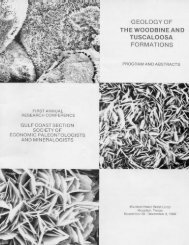Petroleum Systems of Deep-Water Basins - Gulf Coast Section SEPM
Petroleum Systems of Deep-Water Basins - Gulf Coast Section SEPM
Petroleum Systems of Deep-Water Basins - Gulf Coast Section SEPM
Create successful ePaper yourself
Turn your PDF publications into a flip-book with our unique Google optimized e-Paper software.
The Hydrocarbon Habitat <strong>of</strong> the Agadir Basin<br />
Offshore Morocco<br />
Daniel M. Trümpy<br />
Scott C. Reeve<br />
Shell International Exploration and Production, Inc<br />
<strong>Deep</strong>water Services<br />
P.O. Box 576<br />
Houston, Texas 77001<br />
e-mail: dmtruempy@shellus.com<br />
Abstract<br />
The Agadir basin is situated <strong>of</strong>f the Moroccan Atlantic coast and the Canary Islands. It comprises some 80,000 sq<br />
km <strong>of</strong> shelf and deep water acreage, and has been explored by 16 wells, all drilled on the shelf margin. The deep water<br />
basin remains undrilled at present.<br />
In 1998, Shell acquired 2,000 km <strong>of</strong> 2D seismic in the Agadir deep water basin, where previous exploration had<br />
revealed the presence <strong>of</strong> a mobile salt substratum in an area characterised by the presence <strong>of</strong> a world-class source rock<br />
(the Albian -Turonian Tarfaya Shale). On the Jurassic carbonate and Cretaceous clastic shelf, significant oil shows<br />
had been discovered during the seventies.<br />
Key results <strong>of</strong> the 1998 to 2000 Agadir Basin exploration are:<br />
1. The basin is highly structured, due to interaction <strong>of</strong> the Atlas compression with passive margin extension and<br />
halokinesis. This structuring creates a large number <strong>of</strong> potential traps.<br />
2. An Atlas-sourced fluvial system delivers Tertiary turbidites to the basin. Late Cretaceous and Palaeocene sandstones<br />
appear to be derived from the Moroccan Meseta. A Jurassic to Cretaceous delivery system from a more<br />
southerly source is expected to shed older turbidites into the Agadir basin. Erosional scours originating on the<br />
platform confirm that the Cretaceous shelf sands have been transported into the basin.<br />
3. Reservoir quality is a possible concern in an area where carbonate rocks abound in the source area. The main<br />
objective in the northern part <strong>of</strong> the Agadir basin is a Late Cretaceous to Paleogene reservoir play, which ties back<br />
to shelf and fluvial sandstones outcropping onshore in the Souss valley and predates the formation <strong>of</strong> the High<br />
Atlas range. Secondary objectives occur in the Neogene and in the Lower Cretaceous to Jurassic intervals.<br />
4. Geochemical modelling supported by the shows in platform wells and the abundance <strong>of</strong> oil slicks suggests that an<br />
active oil charge system is working in the basin. The world-class Tarfaya Shale is likely to be mature over large<br />
areas. Older source rocks are likely to further contribute to oil (and gas) charge. They comprise Oxfordian and<br />
Liassic shales, but also more speculative Westphalian coals and Silurian shales.<br />
5. Halokinesis is active over the entire area, but increasing in intensity and becoming progressively younger towards<br />
the northern part <strong>of</strong> the Agadir permit, where compressional activity has focused. Locally therefore trap integrity<br />
and/or charge timing may form an issue for truncation plays against piercing salt domes. Other play types in the<br />
Agadir basin consist <strong>of</strong> anticlinal closures over deep-seated salt swells, fault-related structures and stratigraphic<br />
traps.<br />
14

















